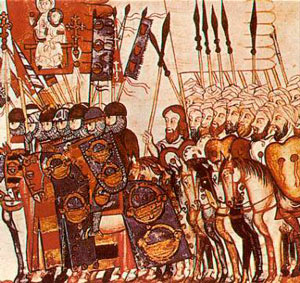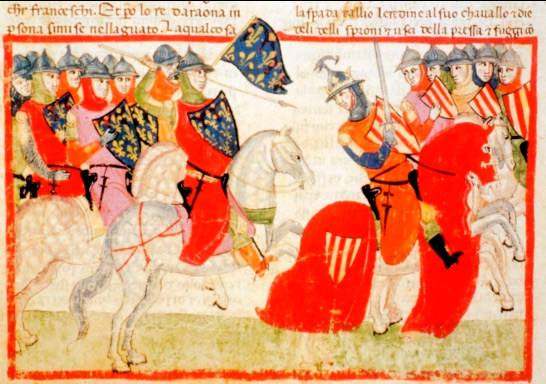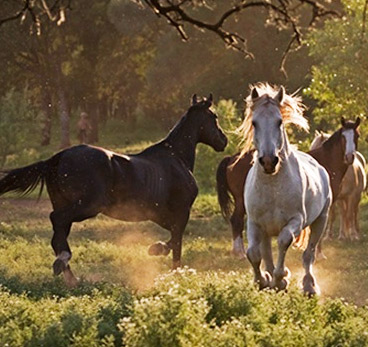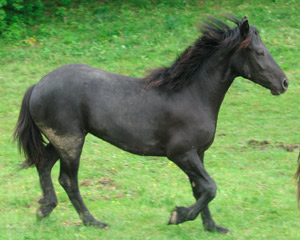

On .M. Rosell i Vilà in 1916 he innovated that "the ceretan horse possessed foot security and resistance to fatigue in all races, fast in the race, sober in food, own for the chair. An excellent war horse. Gustava more of the rider than the tiro, to which he was quite reluctant, but what he took the collar with taste did not have a competitor".
There are historical data that in the Catalan Pyrenees, and especially in the region of Cerdanya, horses were raised since the century. III BC. From the Middle Ages to the beginning of the 20th century, the horses and mules of Cerdanya were highly prized in Spanish markets, especially those in Valencia, Aragon and Castile, where most of the equine personnel necessary for animal traction, transport and the army (Cab√ļs, 1988) went to stop.
But what did our horses tell us about the fifteenth century?, look at manuel Díaz's menescalia book (15th century) that describes Catalan horses as follows:
"De la bellea quel cauall ten hauer.- Lo cauall must hauer lo cap molt sech e decarnat: e lo front wide: e los hulls big e eixits per a fora: e les brows flat e no big: e lo sobrehull swollen or bounced outside: short ears and sharp and right or not hanging at all: the thin and very festive bars and great freu de la huna on the other: on the cheeks little meat: the nartilities very wide and that inside you see redness: the mouth well done and the nose dejus pus llarch quel on top and sb little meat: the neck must be thin and turned upwards, wide towards the shoulders e that goes slimming down to the head and when it is in the head that it is very thin: the silts not very larch ne spessos e que sían blans e prims: e that there was the spatles wide and largues and formed of flesh: e the wide breasts e exits by affora e redons ab canal by mitj. The wide dogs showing departing from the spatles: e lo sollar or two short and flat e not surrounded by emunt or auall: e lolom has flat and wide and grooved: the ribs had wide and largues: the round side in botit, the round belly and large peron hidden inside the ribs amasurably: the large and wide yllades in the wide and flat ancas as caygudes ab canal by the sock and big shot naked: the thighs thick and larga with a lot of flesh low and inside and outside: low tail and firm with big male and enough larch cavells to the ground and that for negunas i largues does not move it. And keep it tight in your thighs. And the success twins and planes: the fried and wide reeds and without child flesh showing all the nirvis and veins: the very short traitor with many deduced hair: the bracos when the cauall is together very wide pus from one to the other on the brahons that do not gild towards the hands. Thin and peeled crowns: and the hands are black and rounded and from the inside very deep and decayed: the wide heel to plan".
If you want to see the horse drawn in this description you can go around the Museum of Art and Archaeology of Barcelona and look for the painting "Sant Vicenç en la foguera", and other paintings, all of the Catalan fourcentistas.
For some time, the Catalan navy has gone to conquer territories transporting horses on their boats. Especially marked are the exploits of the Almogavars, but for any peninsular kingdom has ever had to transport horses, their wars have always been on peninsular territory.

We mention some remarkable fact:
1. Towards the end of 1228 an Arab squadron, from the Balearic Islands, captured two Catalan boats. Jaume I asked the bali, from Mallorca, Abu Yahya, for an economic repair; but the Balin advised by the Genoese was unravelled. In December, courts were held in Barcelona, Jaume I, and the nobles decided to undertake an expedition of conquest against Mallorca. A group of Catalan men presided over by Jaume I meet at Pere Martell's house in Tarragona to prepare for the conquest of Mallorca (1228). The following year, on September 5, 1229, the Catalan estol departed from Salou, Cambrils and Tarragona formed by one hundred and fifty warships.
Count Nunó de Rosselló, Ramon de Montcada, Lord of Tortosa, and Guillem de Montcada, Viscount of Béarn, landed in Sa Palomera (Today Sant Elm), on September 5. They headed towards Mallorca crossing the mountains of Portopí, on the 12th they encountered the Arab troops in the Coll de sa Batalla. The Catalan cavalry, finished by Guillem de Montcada, charged against the Muslims; while the infantry receded. Due to the poor approach, the cavalry was circled by the enemies, and when the infantry arrived, Guillem and Ramon de Montcada were already defeated and killed.
2. There in the years 1276 the Toloriuense were part of the Roussillon and the Capcir of the Kingdom of Mallorca, our King James II had from his castle in Perpignan the recovery of his island territory while defending himself and dared even attack his brother the Count of Barcelona, Peter II the Great, that at the wish of his father the good Count Jacme I, king of Valencia, of Aragon, etc..., had divided his realm into two parts. The splinter of James II of Mallorca and Cerdanya came and went from Mallorca to Perpignan and many times as his descendants enjoyed the protection of the extraordinary port of Collioure and Montpellier.
Jaume II, Count of Cerdanya, where Toloriu belonged, made a good provision of the magnificent horses that were raised in the Pyrenean valleys between Cerdanya and Ariège, were small horses, only 1'45 high, rustic, light, social, capable of resisting days without food and eating any foraging, were the well-known Catalan horses or ceretans, passed to the islands. After 700 years these horses have generated new breeds Mallorquina and Menorca, which give so much joy to the main festivities of towns and cities of the islands.

3. The election of Pope Nicholas III in 1277 allowed us to see the hope of a solution in the conflict in the kingdom of Sicily where Constance, the wife of Peter II the Great demanded hereditary rights, but his death in 1280 and the election of the Pro-French Pope Martin IV will turn things around.
On the eve of Easter 1282 the Sicilian nobleman, John of Procida and the people of Palermo organized a revolt against the Angevins and Charles of Anjou, known as the Sicilian Vespers. During this revolt, which spread throughout the island, all the French on the island were killed. A delegation of Sicilians came to Peter the Great, then in North Africa, and offered him the crown; King Peter set sail from Port Fangós on 7 June 1282, accompanied by almogavars; they landed in northern Tunisia, where the king welcomed the ambassadors. At the beginning of August the Catalan king landed in Trapena (Trampani), where he was received as a hero and remained until August 29. On 4 September he arrived in Palermo, there he learns that Charles of Anjou was harassing Messina, and sent two thousand almogavars with his cavalry while he stayed in Palermo to form an army. The Bishop of Cephalu crowned him King of Sicily on 8 September. On 2 October, King Peter arrived in Messina, when Charles of Anjou had already abandoned the siege.
4. Alfonso the Frank, already king, summoned Cortes to Huesca on 18 October 1286. In these courts it was decided the conquest of Menorca, which remains under Muslim rule. On November 22nd, more than a hundred ships sailed from the port of Salou, with twenty thousand men on board and horses from Ceretans. The fleet made stopovers in Mallorca, where they spent Christmas. On 5 January 1287 the squad anchored on Rabbit Island, now called the King's Island,near Mahon. On the 17th, the Catalan troops landed near the port, besieging the town of Mahon, which was delivered immediately. Rais Abu Umar became strong in the fortress of Santa Àgueda,in the center of the island. Abu Umar,seeing himself dead out, agreed to surrender to Alfonso the Frank. On January 21, both signed the pact, known as"saint Agaiz". Abu Umar,gets exile for him and two hundred people around him. While the rest of the inhabitants of the island become slaves to the king. On the 22nd, Alfonso the Frank enters the "Mandinat Minurca" (Ciutadella), ending the conquest of the island. In 1295, after the death ofAlfonso, James III of Mallorca, he recovered the islands, including that of Menorca.
5. In the first campaign of Naples Alfonso IV of Catalonia called the Magnanimous organized a floe of 16 galleys and 8 smaller ships, each galley was prepared to transport more than 100 horses; on the 1433 expedition he carried more than 6,000 horses on the ships.
6. He arrived on August 3, 1492 and Admiral Joan Cristòfor Colom left from Pals (Girona) with three ships to make a journey of recognition of the lands he knew beyond the towers of Hercules, but on the second voyage that came out on September 25, 1493 from the port of Barcelona we know that he had seventeen ships, three of great tonnage (oaks) and fourteen caravels with 1200 men: 500 sailors and 700 passengers, loaded with seeds, food, quite a few horses, pigs, tools, etc... everything necessary to colonize the new lands, that is, it transported Catalan horses or ceretans to the new lands naturally, as the Catalan admirals had done for years.
This is the first time that horses have set foot on the unknown continent, horses that had never inhabited the great American continent, not even to the north it is known that the Mughals have left horses in the icy part of the continent.
Successive trips brought horses that remained in Hispaniola (Santo Domingo and Haiti) some passed to Cuba, Jamaica, etc. But not on dry land that they were forbidden to colonize.
And now we wonder what it has to do with this oceanic journey with the Catalan horses or ceretans?, simply, that they are the origin of the current mustang horse, which the U.S. government has had to protect to avoid its extinction as happened in our country.

The great American expansion of the Mestenian horse (whose name derives mustang) to the American continent is the arrival of Prince Ferdinand of Aragon, renamed by the Castilian histography by Hernan Cortés in the conquest of Mexico. Ferdinand and his two captains Josep Grau, Baron of Toloriu and Joan Grau of the capital of the Baridà deputy, transported, as the Catalan sailors always did, to the mainland 11 horse and 5 euthanasia ceretanas, those of their exercises, which although it represented a ridiculous cavalry, this one for its impact on the Indians who had never seen such a strange deer. With all the pre-inventions of Bernal Diaz del Castillo's counterfeit work, this one tells us"those of caballo estaban so days and hacianlo so varonilmente, that, after Dios, what keeps us, ellos fueron fortaleza".
After conquering Tenochtitlán, Prince Ferdinand Cortés gave entrustments to the people who accompanied him and the colonization of the land began and therefore the breeding of horses in North America. In 1521 the Viceroyalty of The New Spain was established, which became the focus of the conquests and expeditions of the new continent. All land incursions carried horses, this often were lost or simply lost, finding a few pastures where they could reproduce in the wild and form the wild packs of mustangs.
During the colonization of North America many of these ceretan horses were left free and formed small packs that filled the American steppes of free horses, ceretan horses.
The Native Americans were the first to tame and deal with these horses, although many tribes did not dare to breed them. If the Chickasaw or Cherokee Indians were very skilled with painted horses and later the Nez Percé Indians with the horses moulded. European settlers also captured some specimens. From the 19th century onwards, french and German horses began to cross, higher and more corpulent, while the mixed packs continued to grow on the steppes.
At the beginning of the 20th century the Mustangs reached a population of two million specimens. They became a problem for farmers as they competed with their livestock for pastures. He began his hunt ruthlessly with the approval of the authorities and by the late 1960s the number of mustangs had decreased to about 320,000. Recognizing the problem in 1971, the U.S. Congress passed a law declaring the mustang a protected species.
Our Catalan or Ceretan horse has a racial record with the following characteristics:
On the other hand, they define mustang as a small but very vigorous and courageous horse. With a short neck and small head, the mustang has expressive eyes and a rectilinear test. It has a low rump and dry and hard limbs. It measures between 1'35 metros and 1'55 meters. It is a fast, strong horse capable of surviving in arid and mountainous regions, feeding only on woody plants and thorny shrubs. Animal that drinks little, resists both dry heat and large colds.

This is the imprint that catalan horses have quietly left in the new world, the free horses that escaped the dressage and crossing with the subsequent horses brought from Germany and Castile. In our house if there is still some ceretan horse that is hidden by some remote region, should we recover them?. (The ACCRA Association of Catalonia shyly devotes itself to its criticism).
We thank the Catalans under the rule of the French state that in the tranqui-valleys of the Arièg has managed to maintain the breed that has now taken the name of Merens, precious horses that on the trot wave their black cringe on the green pastures of its valleys.
Afegeix-hi un comentari: